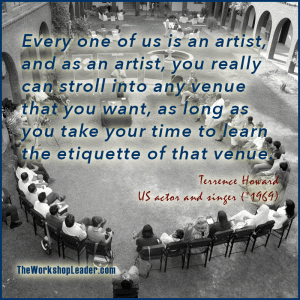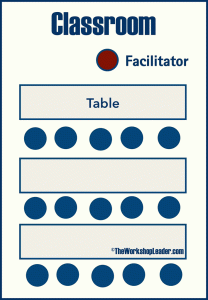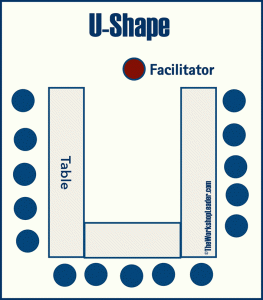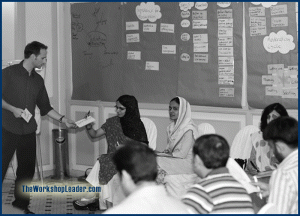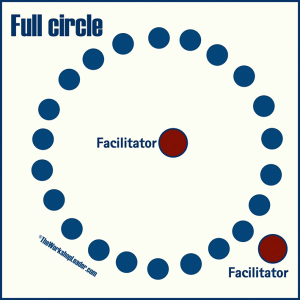Every one of us is an artist, and as an artist, you really can stroll into any venue that you want, as long as you take your time to learn the etiquette of that venue.
Terrence Howard (*1969)
US actor and singer
Venue
Location matters. In order to have good results, both you and the participants have to feel relaxed. An ambiance has to be created that facilitates an open exchange of opinions. This is your task! Do not blame others — the hotel, the participants etc. — as it is up to you to choose the venue (and perhaps the participants, too) and to create a suitable environment [see also Dealing with resources].
Of course, we will never have the ideal environment but there are many ways to improvise. Be creative with the elements available. Prepare your venue minimum one hour before the workshop starts.
The seating arrangements are one part of the venue – not only to make participants feel alright, but furthermore to moderate successfully. Some combination might just lead to failure. So, let’s have a look!
Seating Arrangements
Like the venue itself, seating arrangements create an environment. Seating arrangements can facilitate or hamper communication, enable activity or block it, can support or impede learning.
Basically, there are four types of set-up with their respective advantages and disadvantages:
- School classroom.
- U-Shape.
- Semi-circle.
- Full circle/square.
Let’s deal with them one by one. Then you can make your decision on the basis of what you want to achieve.
School classroom Seating
This is the traditional form of ex-cathedra teaching in which one person talks, the others listen and are under the authority of the speaker permanently. This might be useful for dealing with children but it rarely generates discussion or interactivity. It is unlikely to create a cosy atmosphere.
- Good for focus on board/one teacher.
- Good if there is a lot of writing/computer work.
- Different distance between rows.
- No interactivity.
- Teacher/moderator always between participant and screen/board.
U-Shape
The second traditional form which every hotel automatically arranges — whether you want it or not. This allows people to face each other partially.
Seating arrangements in panel discussions are dealt with later [aModeration].
- Classical form.
- Good for one trainer and if there is a lot of writing/use of computer.
- Slightly boring.
- Hampers interactivity.
Semi-circle
Most of our workshops we conduct in semi- or half-circle — due to its overwhelming advantages: the direct – if needed also physical – interaction. You can switch your roles from moderator to trainer and present a PowerPoint or a film and go back to moderation – all without changing the seating. You can distribute material quickly by yourself. You can collect cards for metaplan. You can immediately get someone in front of the group and back to the seat etc.
Additionally:
- Breaks up shyness.
- Only for little groups.
- Not good if lots of writing is required.
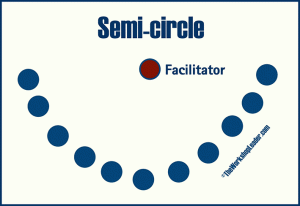
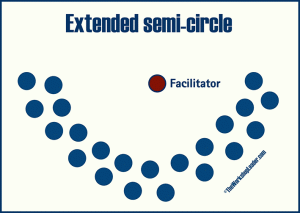
Full Circle
This is the most interactive for the group. As moderator you can stay outside and let the participants interact with each other. Thus, you will be more the wise at the side than the sage on the stage.
But you can also stand in the middle of the circle and interact 360°. Not only in arts the circle is the most perfect form, but it can be also in workshop moderation. Furthermore, it creates an intimate atmosphere of trust and familiarity.
The third option is that the facilitator is part of the circle. So, he or she is line with the group. This underlines his/her equality and might open up the one or other participant as the teacher-pupil-relationship vanishes. The facilitator merges with the group and accompanies the group process from within.
Full circles are also suitable for certain games and energizers. Have a look there!
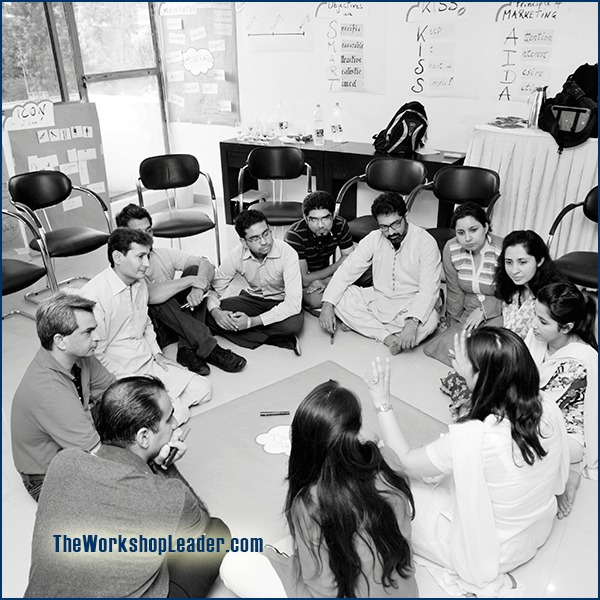
No-go Areas
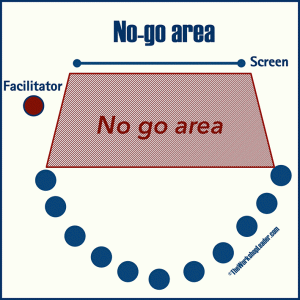
When seating arrangements are set up, you should test — with the help of a colleague or friend — the No-go Areas. These are those areas, which should be avoided as they distort communication. For example, any area where a moderator or trainer blocks a participant’s view of the board, flip chart or screen is a No-go Area.
To find out where these areas are you will need to place your helper in different, extreme positions of the seating (first left, first right, last middle etc.) and move around yourself until your helper says that the view is blocked. This is where the No-go Area begins and you should mark the borderline of your No-go Area with indoor masking tape. You should also let the other facilitators know exactly which areas they should and shouldn’t use.


